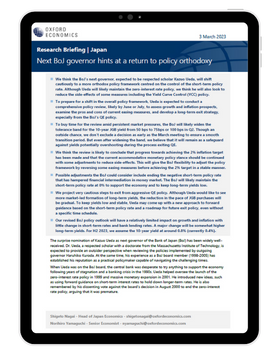Next BoJ governor hints at a return to policy orthodoxy

We think the BoJ’s next governor, expected to be respected scholar Kazuo Ueda, will shift cautiously to a more orthodox policy framework centred on the control of the short-term policy rate. Although Ueda will likely maintain the zero-interest rate policy, we think he will also look to reduce the side-effects of some measures including the Yield Curve Control (YCC) policy.
What you will learn:
- To buy time for the review amid persistent market pressures, the BoJ will likely widen the tolerance band for the 10-year JGB yield from 50 bps to 75bps or 100 bps in Q2. Though an outside chance, we don’t exclude a decision as early as the March meeting to ensure a smooth transition period. But even after widening the band, we believe that it will remain as a safeguard against yields potentially overshooting during the process exiting QE.
- We think the review is likely to conclude that progress towards achieving the 2% inflation target has been made and that the current accommodative monetary policy stance should be continued with some adjustments to reduce side-effects. This will give the BoJ flexibility to adjust the policy framework by reversing some easing measures before achieving the 2% target in a stable manner.
- Possible adjustments the BoJ could consider include ending the negative short-term policy rate that has hampered financial intermediation in money market. The BoJ will likely maintain the short-term policy rate at 0% to support the economy and to keep long-term yields low.
- We project very cautious steps to exit from aggressive QE policy. Although Ueda would like to see more market-led formation of long-term yields, the reduction in the pace of JGB purchases will be gradual.
- Our revised BoJ policy outlook will have a relatively limited impact on growth and inflation with little change in short-term rates and bank lending rates.
Tags:
Related Resouces

Post
Japan’s tariff turbulence to flatten near-term growth
We've cut our GDP growth forecasts for Japan by 0.2ppts to 0.8% in 2025 and by 0.4ppts to 0.2% in 2026, reflecting higher US tariffs and heightened global trade policy uncertainty. We now forecast that Japan's economy will barely grow over 2025-2026 on a sequential basis.
Find Out More
Post
‘Liberation Day’ 24% tariff will limit Japan’s growth
The 'Liberation Day' tariffs, together with separately announced higher tariffs on auto imports to the US, will lead us to cut our growth forecast for Japan. The direct impact of the tariffs will end the modest growth we projected in March, and we now think the economy will barely grow in 2025-2026. This initial estimate does not consider the indirect impact from high trade policy uncertainty and retaliation from other economies.
Find Out More
Post
Japan’s supply-driven food inflation to persist longer than expected
We have revised our CPI forecast upwards for this year and next, due to more persistent supply side-driven food inflation, led by soaring prices of rice. Despite the significant revision to the short-term inflation path, we don't expect the Bank of Japan (BoJ) to react with a rate hike.
Find Out More